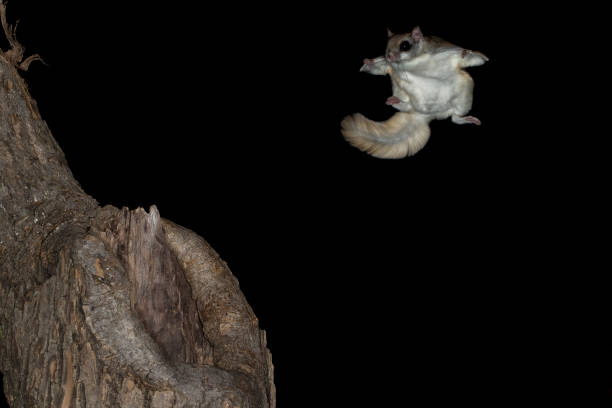5 Minute Read
Written by Stella Nelson

There are two species of flying squirrels that can be found in North Carolina: the Carolina Northern flying squirrel (Glaucomys sabrinus coloratus) and the Carolina Southern Flying Squirrel (Glaucomys volans). Both species live in trees and are nocturnal. The northern flying squirrel species are found more at high elevations on mountain tops, while the southern species can be found all throughout North Carolina. The Carolina Northern Squirrel has been deemed endangered and sightings of this species are extremely rare. Sightings of the Carolina Southern Flying Squirrel are also rare as they’re considered to be the most common unseen mammal in the state. Even so, the Carolina Southern Flying Squirrel has been spotted on Durrant Farms Estate. Right after the damage from Hurricane Helen, employees saw this little furry friend on a tree after a long day of trailwork. She was very shy and hid before scurrying up to the top of the tree and gliding away into the forest. We hadn’t known that there were flying squirrels in North Carolina until then.
Having no prior knowledge on flying squirrels in North Carolina, I decided to do some research to learn more about these small creatures. I found that they are such an uncommon sight despite being pervasive throughout the state as they are nocturnal and move about with extreme caution. These little cuties only weigh 2 to 3 oz. and measure 8-10 in.. This squirrel is a light brown or grey and its belly is creamy white. They have a distinctive patagium, a cape of loose skin that connects wrists to ankles, that is bordered in black. When it opens its patagium to its full extent, it can glide from tree to tree. This gliding looks a lot like flying, hence the name “flying squirrel.” One thing that I thought was interesting is that flying squirrels can direct their glide by contracting muscles in their wrists and ankles. They produce a birdlike chirping sound that is often not audible to the human ear. The flying squirrel is omnivorous: eating nuts, acorns, fungi, berries, fruits, seeds, flower blossoms, eggs, and even animal carcasses. Given that it’s spring time here on the farm, there is plenty to go around for the squirrels, alpacas, and humans. The flying squirrel can live up 15 years in captivity but usually only up to 5 in the wild. Their predators include owls, hawks, snakes, bobcats, raccoons, weasels, and foxes– many of which frequent our woods. However, these squirrels move with such speed and caution that they area difficult prey to catch.

More about the Carolina Southern Flying Squirrel
The flying squirrel lives in hardwood and mixed pine-hardwood forests. They nest and roost in the cavities of older trees or snags(standing dead trees). They have been found roosting with up to 50 of their friends in one tree. They fill their nests with finely chewed bark, grasses, lichen, moss, and even feathers to create a soft bed. Durrant Farms has many acres of mixed pine-hardwood forest and we strive to create ideal conditions for old growth and a healthy forest. These conditions also are great conditions for lots of adorable friends including the Carolina Southern Flying squirrel.
To create the conditions seen in an old growth forest we have several management strategies that are relevant to the Carolina Southern Flying Squirrels. We have dedicated legacy trees that are protected and will age to their full potential. Around these legacy trees will also be protected land that will contain other trees that will not be cut down or disturbed. This is essential for the Carolina Southern Flying Squirrel because these older trees are their preferred nesting habitat and will ensure that they are not disturbed by any unnecessary logging activity. We also have committed to leaving select standing dead trees up that have potential to be home for a variety of species, including the flying squirrel. These standing dead trees also act as an essential jumping point, which they utilize to be able to travel through the forest in their gliding manner.
The Carolina Southern Flying Squirrel is considered to be the most common unseen mammal in North Carolina. We feel really lucky to have witnessed it and look forward to restoring the forest with methods that will benefit the livelihood of the Carolina Southern flying squirrel as well as a variety of other woodland creatures. With intentional management of the forest here on Durrant Farms Estate, we will continue to cultivate unique niches that give shelter to our various friends who make these forests their homes, like the Flying Squirrel.